New in safety: Exposure OLAS Float-On, Vesper smartAIS deckWatch, and Digital Yacht Nomad portable AIS
 The Exposure OLAS Float-On is one hell of a flashlight (or “torch” in Brit speak). That’s because it’s also an automatic water-activated MOB strobe light and a Bluetooth MOB alerting device that can network with smartphone apps and more familiarly styled MOB tags. Details follow, along with several other interesting new safety products that also got the attention of the DAME Award judges at METS…
The Exposure OLAS Float-On is one hell of a flashlight (or “torch” in Brit speak). That’s because it’s also an automatic water-activated MOB strobe light and a Bluetooth MOB alerting device that can network with smartphone apps and more familiarly styled MOB tags. Details follow, along with several other interesting new safety products that also got the attention of the DAME Award judges at METS…
 First, let’s sort out the names. Exposure Lights is a UK firm developing technical “torches” for boating and other demanding niches; OLAS, as in Overboard Location Alert System, is the Bluetooth tag and app MOB system (above) that Exposure rolled out early this year; and the Float-On light is a brand new multifunction addition to the OLAS family.
First, let’s sort out the names. Exposure Lights is a UK firm developing technical “torches” for boating and other demanding niches; OLAS, as in Overboard Location Alert System, is the Bluetooth tag and app MOB system (above) that Exposure rolled out early this year; and the Float-On light is a brand new multifunction addition to the OLAS family.
You may notice that the original OLAS tags and apps seem very similar to the CrewWatcher system I beta tested in January. In fact, the OLAS Float-On and what is now coming to market as the Weems & Plath CrewWatcher were both DAME Award safety category nominees with CrewWatcher receiving the award.
I sympathize with the DAME judges’ comment that starts “After much debate…” because try as they might to be simple to use, these are actually complex communications systems, and the real devil is in details like how well they manage false alarms caused by Bluetooth obstructions. We’ll know more this coming year as lots of reasonably priced CrewWatcher, OLAS and also Sea-Tag smartphone/Bluetooth systems get out into the real boating world.
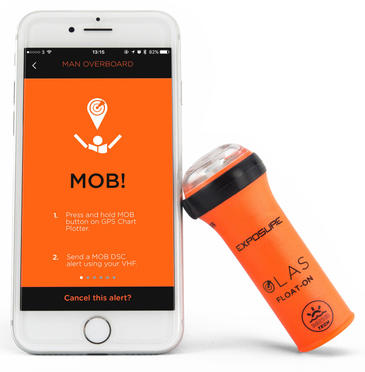 But assuming that one or more of these modern MOB alerting and location systems is truly practical, it seems smart that a compact flashlight/strobe could also serve as a Bluetooth tag. The Float-On may cost about $130 when it ships early in 2018, but, for starters, it’s a floating waterproof rechargeable flashlight with three levels of illumination that range from 10 lumens for 20 hours to 120 lumens for 1 hour.
But assuming that one or more of these modern MOB alerting and location systems is truly practical, it seems smart that a compact flashlight/strobe could also serve as a Bluetooth tag. The Float-On may cost about $130 when it ships early in 2018, but, for starters, it’s a floating waterproof rechargeable flashlight with three levels of illumination that range from 10 lumens for 20 hours to 120 lumens for 1 hour.
Apparently, the two goldplated contacts inset into the base, which enable automatic strobe activation upon submersion, — the Float-On is designed to float LED light up — also support a snap-on USB charging cable. I suppose that there are scenarios where you might regret that you used the flashlight as much as you did one fateful night, but then again a strobe seems the perfect complement to a MOB system that quickly marks where you went overboard but can’t track you after that.
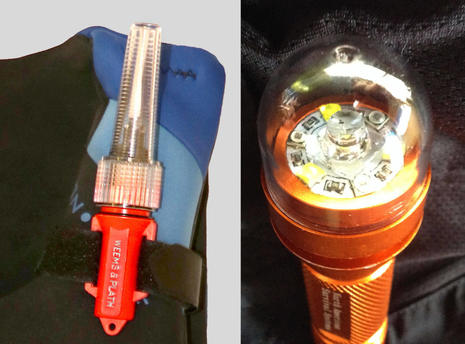 And, incidentally, there are two other new lifejacket strobe lights out this fall. The Weems & Plath Personal Rescue Strobe features a unique visibility-extending light cone — which I plan to test soon — while the North American Survival Systems EF-30A-1 adds three IR LEDs to the normal white lights so it’s visible to search and rescue personnel wearing night vision goggles.
And, incidentally, there are two other new lifejacket strobe lights out this fall. The Weems & Plath Personal Rescue Strobe features a unique visibility-extending light cone — which I plan to test soon — while the North American Survival Systems EF-30A-1 adds three IR LEDs to the normal white lights so it’s visible to search and rescue personnel wearing night vision goggles.
Add all this to the evolving field of AIS MOB devices and don’t you wonder what future personal safety gear will look like?
Vesper deckWatch
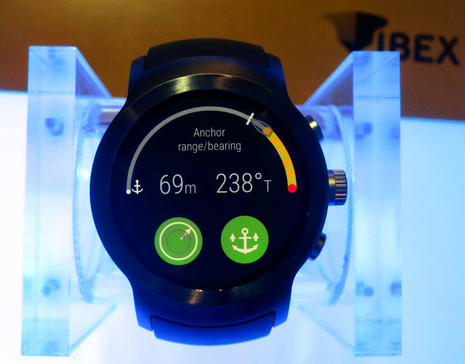 The Vesper deckWatch is the latest element in the smartAIS feature family that rolled out in 2017. It’s an app that runs on Android Wear 2.0 smart watches and integrates via WiFi with Vesper XB8000 and Vision AIS transponders, delivering both the multiplexed boat data those devices have long supported plus new smartAIS features like smartly designed AIS collision, AIS MOB, and anchor drag alarming.
The Vesper deckWatch is the latest element in the smartAIS feature family that rolled out in 2017. It’s an app that runs on Android Wear 2.0 smart watches and integrates via WiFi with Vesper XB8000 and Vision AIS transponders, delivering both the multiplexed boat data those devices have long supported plus new smartAIS features like smartly designed AIS collision, AIS MOB, and anchor drag alarming.
While Vesper only received a DAME nomination for deckWatch — besides the CrewWatcher win, the McMurdo AIS EPIRB received a well deserved Special Mention — the judges in Tampa gave it a 2017 IBEX Innovation Award. That was an interesting debate in which I got to participate.
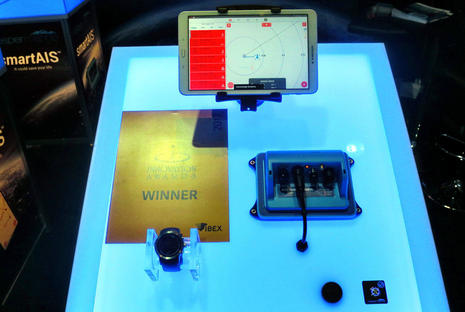 What strikes me as deeply innovative about deckWatch as well as the smartAIS phone and tablet apps is that while they make terriffic use of mobile devices to interface with powerful safety capabilities, the safety is not then dependent on the mobile devices.
What strikes me as deeply innovative about deckWatch as well as the smartAIS phone and tablet apps is that while they make terriffic use of mobile devices to interface with powerful safety capabilities, the safety is not then dependent on the mobile devices.
In the IBEX booth photo above, note the external alarm and switch that now ships with that blue XB8000 AIS transponder. I suspect that using your wrist watch to setup and monitor an anchor watch is great, and I know it’s great to setup and see Vesper’s still-unequaled AIS alarming modes on an iPad, but I think it sensational that the buzzer alarm will still fire off even if the mobile is shut down or busy with something else.
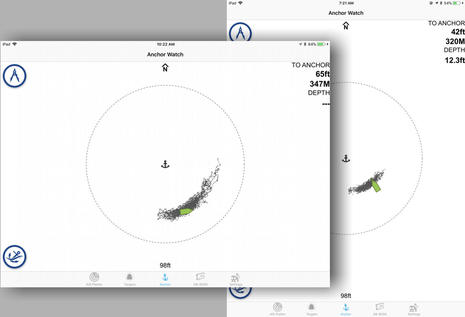 Staying with the smartAIS anchor watch feature, here’s what it often looked like on my iPad as I recently puttered down Chesapeake Bay. Note that you can easily adjust where you think the anchor is relative to your boat, nice because few of us remember to establish a watch when we drop it, and also because the tracking will eventually improve your understanding of where it actually took hold.
Staying with the smartAIS anchor watch feature, here’s what it often looked like on my iPad as I recently puttered down Chesapeake Bay. Note that you can easily adjust where you think the anchor is relative to your boat, nice because few of us remember to establish a watch when we drop it, and also because the tracking will eventually improve your understanding of where it actually took hold.
Also note that with NMEA 2000 input, seen on the right-hand screen, the screen shows Gizmo‘s true heading as well as water depth. I’d like Vesper to add wind speed and direction time graphs to the screen margins when the data is available, and also to change the boat icon to a circle when only COG is known, but that’s icing on the cake.
What’s really smart about “smartAIS” is that the real brains are in the transponder, not in the tablet or watch. So even if I hadn’t run the WatchMate app for hours, an up-to-date anchor watch track history would come up. And, most important if Gizmo dragged outside the watch circle I set, the buzzer went off even if I’d killed the iPad battery streaming videos before falling into a deep sleep.
Digital Yacht Nomad
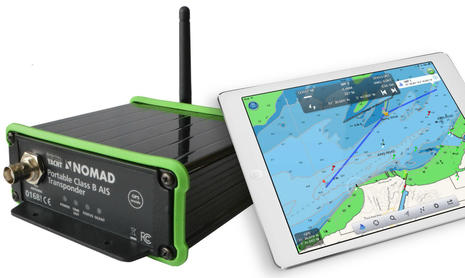 Digital Yacht’s Nomad portable Class B AIS transponder received a DAME Special Mention and as someone who once did numerous yacht deliveries I certainly agree with the judges about its potential usefulness. Moving an unfamiliar boat which may well be brand new and untested — or in that scary gap known as “between owners” — is challenging enough. I remember how incredibly valuable the first handheld GPS receivers were for delivery work, and the Nomad could be the center of an amazing portable nav system.
Digital Yacht’s Nomad portable Class B AIS transponder received a DAME Special Mention and as someone who once did numerous yacht deliveries I certainly agree with the judges about its potential usefulness. Moving an unfamiliar boat which may well be brand new and untested — or in that scary gap known as “between owners” — is challenging enough. I remember how incredibly valuable the first handheld GPS receivers were for delivery work, and the Nomad could be the center of an amazing portable nav system.
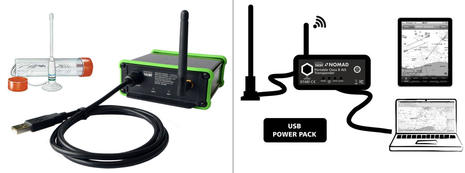 The Nomad uses USB for both power and data, it has WiFi output as well as a built-in GPS with internal antenna, and its included QMAX 10-inch VHF/AIS antenna attaches with a suction cup. Add a USB power pack (like the versatile beauties from Weego), a tablet, and a charting app that can take in GPS and AIS over WiFi (Pocket Mariner SeaNav shown), and you could step aboard with a completely self-contained navigation system that not only displays AIS-equipped vessels along your route but puts your temporary ride on their AIS screens.
The Nomad uses USB for both power and data, it has WiFi output as well as a built-in GPS with internal antenna, and its included QMAX 10-inch VHF/AIS antenna attaches with a suction cup. Add a USB power pack (like the versatile beauties from Weego), a tablet, and a charting app that can take in GPS and AIS over WiFi (Pocket Mariner SeaNav shown), and you could step aboard with a completely self-contained navigation system that not only displays AIS-equipped vessels along your route but puts your temporary ride on their AIS screens.
Now there is an obvious problem with moving boat-to-boat with an AIS that’s still basically designed to be used on one vessel with one MMSI number. In fact, even in areas outside the U.S. where an owner can setup their MMSI into a new Class B AIS, they still can’t change it later. But even here in the U.S. you can change the vessel name and dimensions using PC software, and the Nomad’s USB cable certainly supports PC use too.
While I think that the Class B boat switching issue can be managed without causing trouble, or getting into it, a smaller and less expensive alternative for portable navigation is an AIS receiver. You won’t get the benefit of transmitting your boat position, speed, heading, and (temporary) ID, and I don’t know of an AIS receiver with WiFi built in, but DY’s AIS100 has the power/data USB connection, and the similar AMEC Cypho-150S includes an antenna splitter.
Further off the beaten track — plus even smaller, less power hungry and cheaper — is the dAISy 2+ AIS Receiver. Note that the developer is quite frank about the performance limitations of dAISy’s single chip radio, but I’ll add that even the original single-channel dAISy did fairly well in my testing. I only saw slightly reduced range and sensitivity compared to bigger brand receivers using the same antenna, and the dAISy was easy to setup because there were none of the USB driver issues sometimes encountered with other AIS devices.
Finally, I’ll bet that some clever DIY navigator could built an interesting portable nav system using the dAISy HAT with a Rasberry Pi micro computer, a combination that also seems good as the basis of an inexpensive self-contained Marine Traffic AIS reporting station. If you tackle either project and succeed, please let us know.


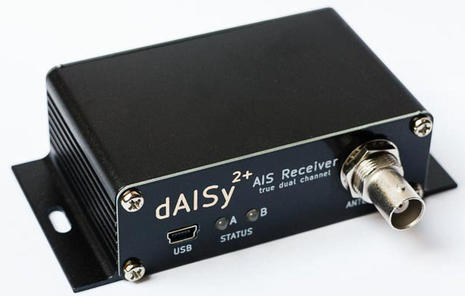











Too bad DY did not include a NMEA 2000 port on the Nomad. It would make it an alternative to the Vesper 8000.
I’ve used the single channel Daisy and it has worked great!
While these smartphone connected devices sound good, when I am offshore my phone is stowed in my bag. Any decent safety device needs to connect to something that is turned on and accessible.
Interesting is the battery time of the MOB devices like Crew Watcher, OLAS and Sea-Tag.
So you don’t have to change or charge batteries all the time.
Hi Atlantis,
Our AIT3000 has NMEA0183/NMEA2000/USB/Wifi and would be a good alternative to the Vesper 8000.
With Nomad we wanted something different; a stand-alone, USB powered, portable and quick to (temporarily) install unit that could be used with any wireless device; PC, Mac, Phone, tablet, etc.
If users have to start pulling out panels, finding spare T-Pieces, etc. They might as well go for our NMEA2000 bus powered AIT1500N2K model.
Best regards
PAUL SUMPNER (Digital Yacht)
I had the opportunity to test Nomad in real life, and I must agree that it is an effective secure device in a “nomad mariner” haversack!
https://blog.francis-fustier.fr/en/essai-du-nomad-lais-autonome-de-digital-yacht/
Francis
Sorry but I don’t understand how just having WiFi and NMEA 2000 makes a transponder a full alternative to the Vesper XB8000?
I may be wrong, but I don’t think many, if any, of the XB8000 features I mentioned above — like four custom collision alarm modes, advanced multiplexing (full GPS, wind, depth, etc), alarms managed by apps but not dependent on them, a watch app, the sophisticated anchor drag presentation, etc — are offered by other Class B AIS transponders with N2K and WiFi.
I’d be happy to be corrected about this.
Hi Ben,
Don’t worry I won’t try to correct you 😉
I was simply highlighting to Atlantis that we already had AIS products in our range that output AIS over NMEA2000 and that Nomad was a solution for a different type of AIS usage.
For some customers, the features that you mention will be a draw but for others hopefully our iAIS (now with Navionics chart support) and new SeaTalk to NMEA0183 interface will keep things competitive.
Thanks, Paul. I just recently noticed the Navionics update to iAIS and think it’s great that there is apparently no further charge for charts if a user already owns them in another app, plus they’re inexpensive if you do have to buy them.
https://digitalyacht.net/iais-gets-navionics-upgrade/
I also think it’s cool that iAIS will forward a user’s boat location to Web sites like Marine Traffic if the mobile device is online. And that feature, like the Navionics charts, is not offered by Vesper’s WatchMate app.
But my main point is that NMEA 2000 and WiFi only suggest many of the features an AIS device can offer; they do not guarantee that the features are actually offered.
Paul @ DY
Thank you for the info. I like that the AIT3000 has a built in splitter too.
Atlantis
I don’t understand how it is legal to use a Nomad AIS on multiple boats? In the USA, AIS modules must be programmed by the dealer even though end users are able to. End users are not able to change the MMSI at all once programmed, only dealers can do this and many charge for the service. This concept kindof ruins the value of the portability of the AIS.
Hi Amity, the possible problem is the same everywhere. Even where an owner can program their MMSI into their transponder, they can not change it.
However, it is sometimes possible to change the boat an MMSI is registered to. For instance, if you get a free MMSI at BoatUS you can easily change the vessel name, size, etc., even add notes about what you’re doing with it.
You can also change the boat name, size, etc. in the transponder, in some cases with an associated app.
Finally, if you got an MMSI for a ‘virtual’ vessel — like say “Capt Amity” — I don’t think it would mess up the system and I doubt you’d get in trouble. Not that I’m advising it…
Nomad AIS questions by email:
“I saw your article in PMY magazine this past month concerning the NOMAD portable AIS transceiver and thought I’d comment.
I frequently deliver yachts between the Midwest points on the coast. Navigating the inland waterways makes AIS really important in order to adequately and professionally communicate with commercial traffic.
With some consternation I’ve been using a device from Quark Electronics. https://www.quark-elec.com/marine/156-qk-a027-wireless-ais-gps-receiver-with-seatalk-converter
It allows me to have a portal AIS receiver onboard which broadcasts to WIFI with the bonus of a backup GPS receiver. I connect my Ipad to its wireless network and display AIS targets in a number of apps that accept NMEA 0183 sentences over WiFi. (Primarily I use SeaIQ). All-in, I’ve got less than $150 into the device with associated antennas! My only concern with the entire set-up is that it’s not FCC approved so I consider it a hobby device… J
In regard to the NOMAD AIS device from Digital Yachts, is it FCC approved? Does it allow the changing of MMSI’s as it is moved between vessels? Would setting this up with a Portable VHF MMSI license be the way to go?
Thanks for having a great website and for all your contributions to the community.”
Thanks and no worries about your Quark AISrx/MUX/WiFi server. No AIS receivers are FCC approved because they don’t transmit and therefore can’t mess with the system. In fact, it looks like Quark has numerous interesting products.
The Nomad has to be FCC approved to be sold in this country because it is a full transponder. But there is no such thing as an AIS transponder whose MMSI can easily changed. I’ll ask Digital Yacht here in Miami what they advise, but as explained above, I do think that there are reasonable workarounds.
How about a small vessel named “Delivery Skipper Xxxxx” for the MMSI or your Nomad and portable DSC/GPS/VHF?
Good stuff Ben! I wasn’t aware an AIS receiver didn’t require FCC approval. Of course this particular device does transmit WiFi, but, a very limited range. I doubt I’d see the network it creates 10′ from the boat.
I think changing the MMSI as necessary before a delivery would work. In fact, most boats I move don’t have an MMSI programmed into their radio. New boats for sure.
Thanks,
-Matt
@Paul_DY:
Dear Paul,
being based in Europe, will I be able to change the MMSI number of the NOMAD using the PC config tool?
This is critical, as I intend to use the NOMAD during charter trips.
Thanks,
Stefan
The vessel name and the search & rescue information on the FCC’s site (where you apply for a call sign and MMSI in the US) can be changed online (but not the official gov’t registration number) so at least the MMSI will show a different boat name.